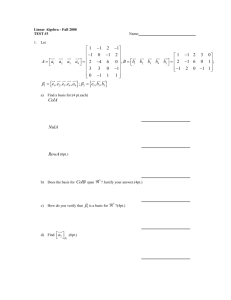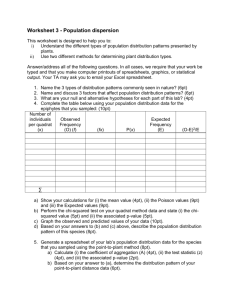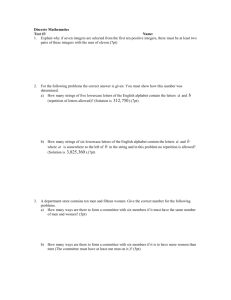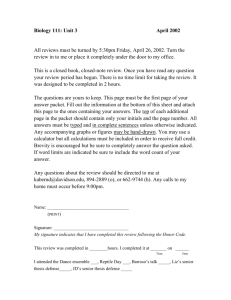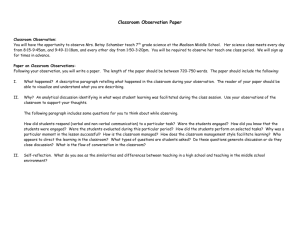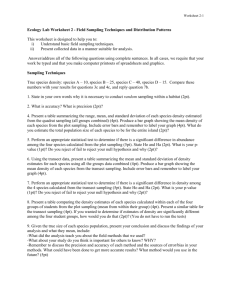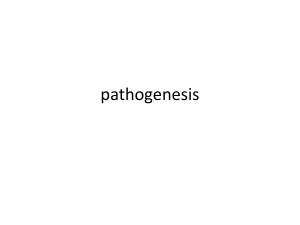Biology 111: Unit 3
advertisement
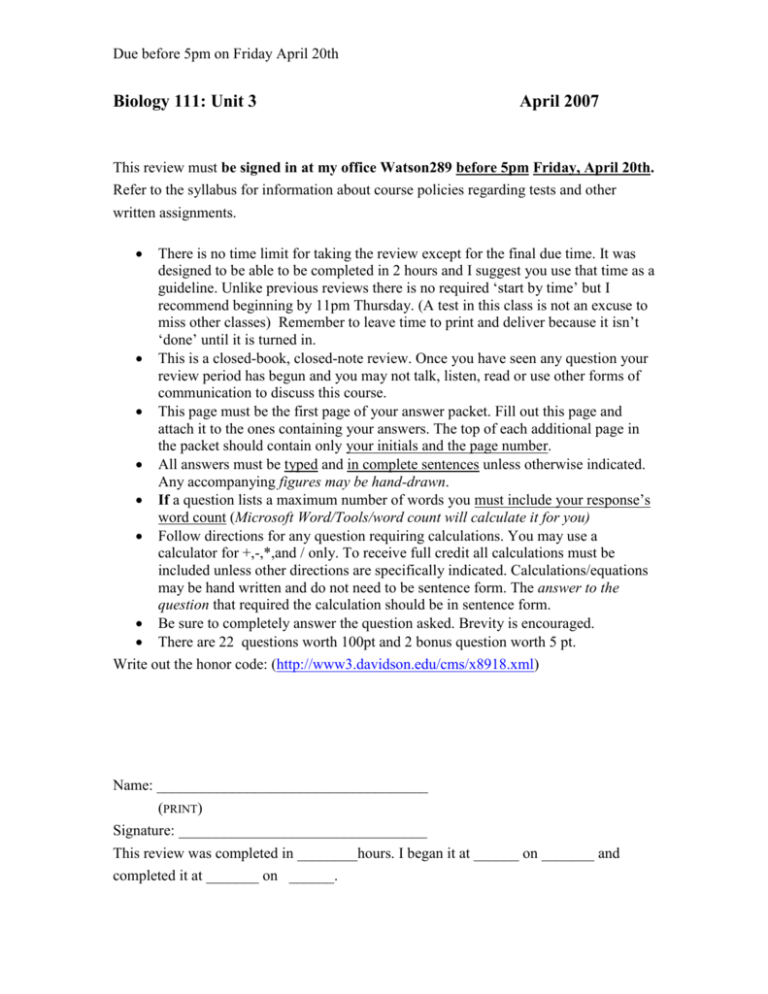
Due before 5pm on Friday April 20th Biology 111: Unit 3 April 2007 This review must be signed in at my office Watson289 before 5pm Friday, April 20th. Refer to the syllabus for information about course policies regarding tests and other written assignments. There is no time limit for taking the review except for the final due time. It was designed to be able to be completed in 2 hours and I suggest you use that time as a guideline. Unlike previous reviews there is no required ‘start by time’ but I recommend beginning by 11pm Thursday. (A test in this class is not an excuse to miss other classes) Remember to leave time to print and deliver because it isn’t ‘done’ until it is turned in. This is a closed-book, closed-note review. Once you have seen any question your review period has begun and you may not talk, listen, read or use other forms of communication to discuss this course. This page must be the first page of your answer packet. Fill out this page and attach it to the ones containing your answers. The top of each additional page in the packet should contain only your initials and the page number. All answers must be typed and in complete sentences unless otherwise indicated. Any accompanying figures may be hand-drawn. If a question lists a maximum number of words you must include your response’s word count (Microsoft Word/Tools/word count will calculate it for you) Follow directions for any question requiring calculations. You may use a calculator for +,-,*,and / only. To receive full credit all calculations must be included unless other directions are specifically indicated. Calculations/equations may be hand written and do not need to be sentence form. The answer to the question that required the calculation should be in sentence form. Be sure to completely answer the question asked. Brevity is encouraged. There are 22 questions worth 100pt and 2 bonus question worth 5 pt. Write out the honor code: (http://www3.davidson.edu/cms/x8918.xml) Name: ____________________________________ (PRINT) Signature: _________________________________ This review was completed in ________hours. I began it at ______ on _______ and completed it at _______ on ______. Due before 5pm on Friday April 20th Springtime in North Carolina is a wonderful, terrible time. It is wonderful because the days grow longer and warmer, the plants and flowers grow and the world seems to shake off winter. It is terrible because as the days grow longer and warmer, the plants and flowers grow and they all seem to shake off their pollen during the same two-week period. In addition, a recent wind storm seems to be determined to blow off any pollen that didn’t fall off on its own. All this pollen shaking is wonderful for the plants but hard on the allergies. Allergy sufferers find themselves dealing with stuffy clogged noses and feeling tired. The plight of your allergy-suffering friends (and yourself, perhaps) has left you considering why there are all these tired faces and how plants and animals deal with energy. 1. Define energy and contrast that term with bioenergetics (4pt) 2. The study guide describes life/living as an endergonic process. What is an endergonic process and why does living fit in that category? (4pt) 3. What is the cellular energy currency? In your response provide its name and what type of molecule it is. (2pt) 4. Begin with the consequences of a stuffed up nose nose and provide connections to your cells experiencing decreased energy levels (‘cellular tiredness’). (6pt) Even with a stuffed up nose, springtime always leads to thoughts of one thing … gardening. You ask for, and receive, permission to plant a small garden out by the Davidson green house (yes we have a greenhouse, beyond the senior apartments, by the practice fields). You begin to prepare the plot by spraying it with ‘KilzIt’ (a commercially available herbicide) to kill the grasses and weeds that currently live there. The packaging says that the product works in 24 hours and that it is specific for plants. After researching KilzIt online you learn that it works by blocking photophosphorylation. 5. Why is photosynthesis so important and why do we need plants more than they need us? (5pt) 6. Why is the "form" (the structure) of chloroplasts critical to energy production? (5pt) 7. Paraquat also kills plants. Explain the mechanism of paraquat’s action. (5pt) 8. Hypothesize a mechanism by which KilzIt could be killing the plants (assume that KilzIt does not work by the same mechanism that paraquat does). (4pt) 9. What are substrate level phosphorylation and oxidative phosphorylation? (6pt) Given your response in #8, explain whether you predict that KilzIt would affect these two processes. (4pt) (total of 10pt) While waiting for the herbicide to work you sit near your garden plot and dig a small hole in the ground. You remember your Bio111 lab and realize that the dirt in your hand probably contains hundreds of the photosynthetic organism that you studied. You decide to isolate the organism and study the effects of toxins on its ability to regenerate flagella. Due before 5pm on Friday April 20th Your toxin of choice is Cholera toxin, a toxin produced by the bacterium Vibrio cholerea. This bacterium lives in freshwater and secretes a protein-based toxin that wreaks havoc by entering host cells and blocking exocytosis. You deflagellate a 3ml algae culture. Half of the culture is treated with Cholera toxin, the other half is not. You follow regeneration for 60min and obtain the data seen in the ‘datatable.xls’ file found on BLACKBOARD. 10. What is the Latin name of that organism (genus and species)? (1.5) 11. What are endotoxins and exotoxins? Given the description above, which category does Cholera toxin fall into and why? (7pt) 12. Download the ‘Datatable’ file from Blackboard. Graph the results of your experiment including appropriate statistical analyses. You should use the functions available in Excel and put the analysis on the spreadsheet. Put the graph on the same sheet as the data table, and eMAIL that file to me. (note: no complete sentences or writing out of equations are required) (5pt) 13. Consider the 15min timepoint on your graph. Which datapoint (+Cholera toxin or no Cholera toxin) is a better representation of the true length of that populations of algae’s flagella length at that timepoint? Explain how your statistical analysis supports your answer. (4pt) 14. Considering what you know about flagella regeneration and Cholera toxin’s function provide an explanation for the trends seen. (6pt) Bonus: Your stock bottle contains 5ml of 70% w/v Cholera toxin. Explain how to set up a treatment that contains the Cholera toxin concentration of 1.3ug/ml. (3pt) Your algae experiments complete, you return to your garden. Since you only have a small area you want to make sure that you get the highest crop yield possible from each plant. To do this you choose to plant pinto beans, corn, tomatoes, and chicpeas (also known as garbanzo beans). 15. Later in the season you pull out a pinto bean plant and notice large nodules on its roots. Describe the process that occurs in the nodules and explain why that process is critical to your bountiful harvest and critical for your existence. (7.5pt) After the harvest you make a salad using some of each of your vegetables. A friend says that you better not eat like that all the time; that you better get some meat in that meal or you’ll be sickly. 16. Knowing what you know about biology, do you agree with him? Beyond the fact that the vegetables are fresh, are they, metabolically speaking, a healthy diet? Explain your response. (5pt) After responding to your friend you think about the wonders of metabolism some more and remember the following reaction. Isocitrate + NAD+ + Mg2+ Alpha ketoglutarate + NADH + Mg2+ + CO2 Due before 5pm on Friday April 20th 17. In what metabolic pathway does this reaction take place? Where is that pathway located in the cell? (3pt) 18. The redox reaction includes NAD+ as a component. What role does NAD+ play in the reaction? (2pt) 19. The forward reaction requires a source of NAD+. What specific metabolic pathway(s) in tomato leaves that we have discussed could provide a source of NAD+ for the plant? (4pt) 20. The products of this reaction can also be used to make an amino acid. Which one? (Include its name and three letter abbreviation) (2pt) BONUS: Draw the amino acid you named in #20 and one additional amino acid of your choosing (provide names) (2pt) A company contacts you to test a new compound that works by completely inhibiting the forward reaction written above 21. Will their product be a safe and effective herbicide? (Your response should include a discussion of the amt of ATP that would be produced in a plant before treatment and whether this compound would increase/decrease/not effect that level) (5pt) 22. Dr. Bernd, why didn’t you ask about ____? I studied it for 2hours and you didn’t ask. This is your chance. Write and answer a question that relates to the Bioenergetics unit. It must cover a topic that was not specifically asked about in the previous 21 questions. My advice—it is a three-point question, keep it short and direct. Do not ask yourself to write a book. (3pt) (Have a good Earth Week!)
